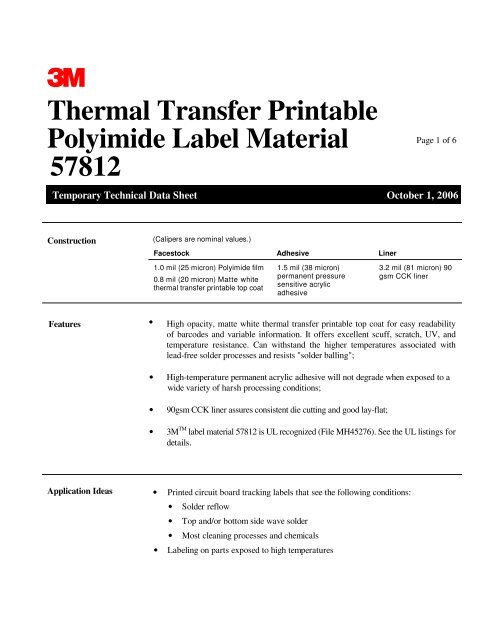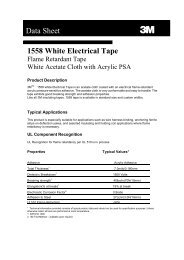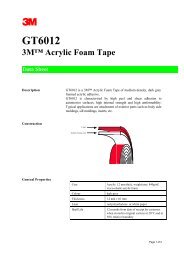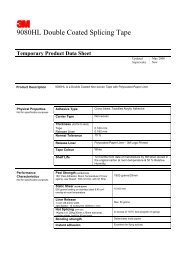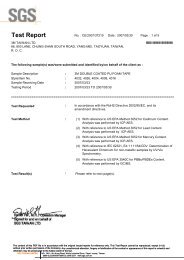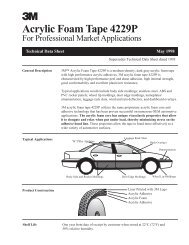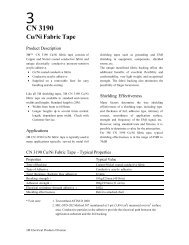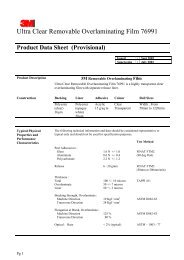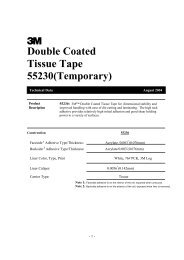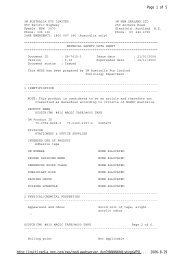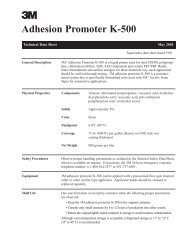S Thermal Transfer Printable Polyimide Label Material 57812
S Thermal Transfer Printable Polyimide Label Material 57812
S Thermal Transfer Printable Polyimide Label Material 57812
Create successful ePaper yourself
Turn your PDF publications into a flip-book with our unique Google optimized e-Paper software.
<strong>Thermal</strong> <strong>Transfer</strong> <strong>Printable</strong><strong>Polyimide</strong> <strong>Label</strong> <strong>Material</strong><strong>57812</strong>Page 1 of 6Temporary Technical Data Sheet October 1, 2006Construction(Calipers are nominal values.)Facestock Adhesive Liner1.0 mil (25 micron) <strong>Polyimide</strong> film0.8 mil (20 micron) Matte whitethermal transfer printable top coat1.5 mil (38 micron)permanent pressuresensitive acrylicadhesive3.2 mil (81 micron) 90gsm CCK linerFeatures • High opacity, matte white thermal transfer printable top coat for easy readabilityof barcodes and variable information. It offers excellent scuff, scratch, UV, andtemperature resistance. Can withstand the higher temperatures associated withlead-free solder processes and resists "solder balling";• High-temperature permanent acrylic adhesive will not degrade when exposed to awide variety of harsh processing conditions;• 90gsm CCK liner assures consistent die cutting and good lay-flat;• 3M TM label material <strong>57812</strong> is UL recognized (File MH45276). See the UL listings fordetails.Application Ideas • Printed circuit board tracking labels that see the following conditions:• Solder reflow• Top and/or bottom side wave solder• Most cleaning processes and chemicals• <strong>Label</strong>ing on parts exposed to high temperatures
3M <strong>Thermal</strong> <strong>Transfer</strong> <strong>Printable</strong> <strong>Polyimide</strong> <strong>Label</strong> <strong>Material</strong><strong>57812</strong>Page 2 of 6Typical PhysicalPropertiesNote: The following technical information and data should be consideredrepresentative or typical only and should not be used for specification purposes.Adhesion: 180° peel test procedure is ASTM D 3330.Initial(10 Minute Dwell/RT)Conditioned for 3 Days at RoomTemperature 72°F (22°C)180° Peel 180° PeelSurface Oz./In. N/100 mm Oz./In. N/100 mmStainless Steel 32 35 53 58Polycarbonate 34 37 58 63Epoxy PC Board 44 48 62 68Conditioned for 3 Day at120°F (49°)Conditioned for 24 Hours at 90°F(32°C) at 90% Relative humidity180° Peel 180° PeelSurface Oz./In. N/100 mm Oz./In. N/100 mmStainless Steel 66 72 64 70Polycarbonate 56 61 62 68Epoxy PC Board 67 73 44 48Liner Release:180° Removal of Liner from FacestockRate of Removal Grams/Inch Width N/100 mm90 inches/minute 150 5.7300 inches/minute 111 4.2Loop Tack: 20 N (ASTM D 6195 (speed 304.8mm/min)test by Instron 5565)
3M <strong>Thermal</strong> <strong>Transfer</strong> <strong>Printable</strong> <strong>Polyimide</strong> <strong>Label</strong> <strong>Material</strong><strong>57812</strong>Page 3 of 6EnvironmentalPerformanceThe properties defined are based on four hour immersions at room temperature(72°F/22°C) unless otherwise noted. Samples were applied to stainless steel panels 24hours prior to immersion and were evaluated one hour after removal from the solutionfor peel adhesion. Adhesion measured at 180° peel angle (ASTM D 3330) at 12inches/minute.Chemical Resistance:Adhesion to Stainless Steel Appearance Edge PenetrationChemical Oz./in. N/100 mm Visual MillimetersIsopropyl Alcohol 47 51 No change 053 58Detergent(1% Alconox®*)No change 096 105Engine Oil (10W30)@ 250°F (121°C)No change 0Water for 48 hours 54 58 No change 0pH 4 53 58 No change 0pH 10 50 55 No change 0409®* Cleaning Solution 51 56 No change 0Toluene 25 27 No change 0Acetone 13 14 No change 0Brake Fluid 53 58 No change 2Gasoline 39 43 No change 1Diesel Fuel 49 54 No change 0Mineral Spirits 47 51 No change 0Hydraulic Fluid 49 54 No change 0Temperature Resistance:536°F (280°C) for 1 minute: no significant visual change500°F (260°C) for 7 minutes: no significant visual change-40°F (-40°C) for 24 hours:no significant visual changeHumidity Resistance:24 hours at 100°F (38°C) no significant change in appearanceand 100% relative humidity: or adhesionAccelerated Aging:ASTM D 3611: 96 hours at 150°F (65°C) and 80% relative humidity:180° Removal of Linerfrom Facestock180° Peel Adhesionfrom Stainless SteelRate of Removal Grams/Inch Width N/100 mm90 inches/minute 169 6.5Rate of Removal Oz./In. Width N/100 mm12 inches/minute 34 37
3M <strong>Thermal</strong> <strong>Transfer</strong> <strong>Printable</strong> <strong>Polyimide</strong> <strong>Label</strong> <strong>Material</strong><strong>57812</strong>Page 4 of 6Printed <strong>Label</strong>Performance:Samples were printed with a Wel R531 resin ribbon on a Zebra 170XiIII printerat a rate of 2 in./min. and a burn temperature setting of 22. <strong>Label</strong>s were printed with a3:1 ratio barcode with 6 mil. X-dimension. Printed labels were exposed to the listedconditions, which are representative of PCB assembly conditions. After chemicalexposure, labels were rinsed with tap water, dried and examined.ConditionPrint Contrast Signal(PCS)Read Rate<strong>57812</strong> Control 97 100530° F, 30 sec. 97 100500° F, 7 min. 94 100IPA 75%, 106° F, 15 min. 97 100IPA 100%, RT 2 min. 97 100Deionized Water, 140°F, 5 min. 97 100Alconox* 10%, 135° F, 2 min. 97 100D-Limonene RT, 2 min. 97 100Monoethanolamine, 135° F, 2 min. 97 100BIOACT* EC-7R, 77° F, 10 min. 92 100BIOACT* EC-15, 77° F, 10 min. 92 100Wave Solder 95 100The Print Contrast Signal, PCS, was determined using a PSC QUICKCHECK 850,with a 0.003” aperture, 660 nm wavelength. The read rate was determined using aPSC laser diode scanner, model 4100. Wave soldering was performed on anElectrovert Co., Microline 250 wave solder machine. Preheat temperature was 250°F, solder temperature was 470° F, line speed was 2 ft./min. Boards were pre sprayedwith a Kester Solder Co. 923 flux.
3M <strong>Thermal</strong> <strong>Transfer</strong> <strong>Printable</strong> <strong>Polyimide</strong> <strong>Label</strong> <strong>Material</strong><strong>57812</strong>Page 5 of 6Shelf LifeOne year from date of manufacture of product when properly stored at 72°F (22°C)and 50% relative humidity.ProcessingPrinting:Facestock is topcoated and is designed for thermal transfer printing.* Recommended Resin RibbonsWel: R531Union Chemicar: US300The following ribbons can be used but may require higher burn temperatures:Sony: 5070Mid City Columbia: CGL-80HEDai Nippon: R510Ricoh: B110AZebra: 5095Die Cutting:Rotary die cutting is recommended.Dispensing:Hand dispensing is recommended.Packaging:Finished labels should be stored in plastic bags.
3M <strong>Thermal</strong> <strong>Transfer</strong> <strong>Printable</strong> <strong>Polyimide</strong> <strong>Label</strong> <strong>Material</strong><strong>57812</strong>Page 6 of 6Special Considerations For maximum bond strength, the surface should be clean and dry. Typical cleaningsolvents are heptane and isopropyl alcohol.****NOTE: When using solvents, read and follow the manufacturer’s precautions anddirections for use.For best bonding conditions, application surface should be at room temperature orhigher. Low temperature surfaces, below 50°F (10°C), can cause the adhesive tobecome so firm that it will not develop maximum contact with the substrate.Higher initial bonds can be achieved through increased rubdown pressure.Technical Informationand DataProduct UseThe technical information and data, recommendations, and other statements provided are based on testsor experience which 3M believes to be reliable, but the accuracy or completeness of such information is notguaranteed.Please remember that many factors can affect the use and performance of a 3M product in a particularapplication. The materials to be bonded with the product, the surface preparation of those materials, theproduct selected for use, the conditions in which the product is used, and the time and environmentalconditions in which the product is expected to perform are among the many factors that can affect the useand performance of a 3M product. Given the variety of factors that can affect the use and performance of a3M product, some of which are uniquely within the user’s knowledge and control, it is essential that theuser evaluate the 3M product to determine whether it is fit for a particular purpose and suitable for theuser’s method of application.Warranty andLimited RemedyLimitation of LiabilityThe 3M product will be free from defects in material and manufacture for a period of one (1)year from the date of manufacture. 3M MAKES NO OTHER WARRANTIES ORCONDITIONS, INCLUDING, BUT NOT LIMITED TO, ANY IMPLIED WARRANTY OFMERCHANTABILITY OR FITNESS FOR A PARTICULAR PURPOSE OR ANY IMPLIEDWARRANTY ARISING OUT OF A COURSE OF DEALING, CUSTOM, OR USAGE OFTRADE. User is responsible for determining whether the 3M product is fit for a particularpurpose and suitable for user’s method of application. If the 3M product is proved to bedefective within the warranty period stated above, your exclusive remedy and 3M’s soleobligation shall be, at 3M’s option, to replace or repair the 3M product or refund thepurchase price of the 3M product.Except where prohibited by law, 3M will not be liable for any loss or damage arising from the 3M product,whether direct, indirect, special, incidental, or consequential, regardless of the legal theory asserted,including, but not limited to, contract, warranty, negligence, or strict liability.* Trademarks listed are the property of their respective owners.Industrial Tape and Adhesive Division3M China Ltd.Shanghai, 200233P. R. ChinaPrinted in P. R. China.Copyright 20063M China all rights reserved


